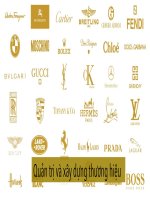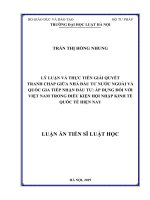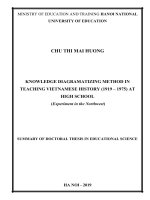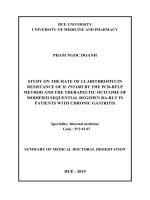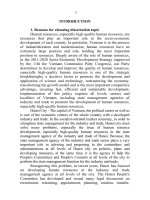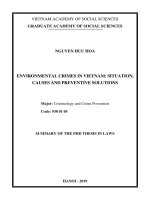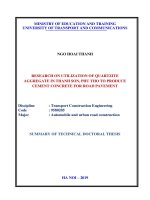GIÁ TRỊ THƯƠNG HIỆU NƯỚC GIẢI KHÁT TẠI THỊ TRƯỜNG VIỆT NAM CÁCH TIẾP cận đa CHIỀU tt tiếng anh
Bạn đang xem bản rút gọn của tài liệu. Xem và tải ngay bản đầy đủ của tài liệu tại đây (469.33 KB, 24 trang )
This dissertation was submitted in fulfillment of the requirements for the Degree of Doctor in
Lac Hong University
Supervisors: Prof., Dr. Hoàng Thị Chỉnh
Reviewer 1:……………………………………………………………………
Reviewer 2: …………………………………………………………………...
Reviewer 3:……………………………………………………………………
Independent reviewer 1:…………………………………………………………..
Independent reviewer 2:…………………………………………………………..
This dissertation was defended in the Doctor of Philosophy Committee in Lac Hong
University at….. /…./……
This dissertation can be publicly found in Lac Hong University library
CHAPTER 1: AN OVERVIEW OF THE STUDY
1.1 Rationales
1.1.1 Reality background
Information technology developed rapidly, along with the process of globalization, making
products that were manufactured with high specializing in the same design, quality and use, with
little differences in comparison with others. Thus, competitive advantages of products created for
enterprises, the factor that makes customers choose this product, but no other products are the
brand of the enterprise (Aaker, 1991, 1996; Keller, 2008; Atilgan et al, 2009). In 2015, three
brands: Apple, Google, Coca-cola were considered as the leading brands by Interbrand
organization, all these successful brands belong to multinational corporations. This shows that
developed countries with large corporations have been considered branding for a long time and
have invested appropriately in the processes of building these brands.
Big brand managers have realized that the process of brand establishment and development
needs not only large but also long-term investment capital, a brand is built not only in a short time
but also with a long-term strategic vision. Thanks to many strong brands like P&G (Procter &
Gamble) with lots of shampoo, washing powder product lines such as Pantene, Head and Shoulder,
Tide; Unilever with Sunsilk, Clear, Omo; Coca-cola or Pepsi of multinational corporations joined
the Vietnamese market in the 1990s, brand activities in Vietnam are considered, invested and
developed. However, the brand was still a new issue and has not been properly invested because
of the issues of Vietnamese economy in the 1990s, so branding activities are only considered by
multinational corporations. Vietnamese enterprises, the period of 1990 - 2000, have not really
appreciated and implemented the branding process, but only have focused on production factors
to increase the volume of products and turnover. In the 2000s, the process of implementing
marketing strategies to build up brand names began to be properly recognized by Vietnamese
enterprises and started to build their brands, Trung Nguyen coffee brand is a bright spot among
the Vietnamese brands pioneering in branding. Recently, some other brands such as Number One
of Tan Hiep Phat (THP), or Vinamilk milk of Vinamilk company are formed and are widely
remembered by customers. Following the success of big enterprises, confectionery enterprises
such as Kinh Do, Bibica, or beverage enterprises like Tribeco, Chuong Duong have focused on
branding process for their products. Looking at the good results of Vietnamese brands in the fight
to create a brand, it can be seen that branding has helped enterprises and their products to confirm
their position in the market. Because the more famous brands are, the more consumers will be in
the product based on the perceived value that they receive when purchasing and using the product.
Thus, To Vietnamese enterprises in the context of a developing and competitive market,
Vietnamese enterprises are quite young in comparison with multinational corporations, brand
problems become an urgent issue assuring the survival and development of each product and each
enterprise. However, not every investment in branding is successful, which is a practical lesson
that many Vietnamese enterprises are stumbling on. Enterprises operating in the FMCG (Fast
Moving Consumer Goods) market are the ones that face the major risk of branding failure. Along
with the socioeconomic development, the demand for FMCG has become larger than ever, so it
can be said that the FMCG market is not only a big market but also a growing one at extremely
fast speeds. Therefore, enterprises, large investors in many different countries are invading and
participating in this market to share a big pie.
In the FMCG market, the industry has the fastest growth rate, a large market and has always
been a dynamically changing industry to adapt to the changing market has been beverage industry.
The world's leading enterprises in this industry such as Coke, Pepsi, Nestle all participate in
branding competition and promotion for their products. Therefore, many researchers invested time
and money in studying about the process of building a brand and its elements to create the best
efficiency. However, in fact, beside some enterprises have a successful branding process and are
accepted by consumers, there are many enterprises failing in building their brand.
Although beverage brands in Vietnam appear quite late because the Vietnamese beverage
market was found later than that of the world. This market is a big one and a playground of top
brands that have built the brand loyalty among most of the customers. The result of the market
report of Nielsen in 2017 shows that the beverage industry is the industry that has high and stable
speed of growth in consumer goods group with the speed increases 45% in the first quarter of 2017
in comparison with 13% of food industry and 17% of the tobacco industry. Because this has high
speed of growth and is a potential market, so the issue of beverage branding is one of extremely
important issues.
1.1.2 Theory background
Many enterprises in Vietnamese FMCG section have invested time and money into
studying about branding process and constructive elements of brand to create the most effective
impacts. However, facts point out that there are many enterprises have faced the failures in
branding process besides ones that succeed in that process and receive the public recognition.
When studying about brand and the method of branding, Keller and Lehmann (2006) stated
that, to administer a brand effectively, marketers need to understand clearly the value of the brand,
besides that, Tho and Trang (2011) stated that, building and developing a brand require not only
properly understanding and having awareness of the role of elements that constitute the brand
equity, the brand equity itself with the method of measuring and calculating these elements but
also perceived value factors when the customers purchase and use the products of a brand, which
contribute to the success of the brand.
Through the theoretic brand study, there is lacking in multi-dimensional evaluation studies,
considering many perspectives, many points of view about the relationship between brand equity
and its components by different objects. Besides that, the impact relationship between the elements
of brand equity has not yet been deeply studied while there is a big difference between needs and
wants of immediate consumers and retailers with brand products. Therefore, there will be different
evaluations of these object groups about brand equity components (Fairhurst and Fiorito, 1990;
Quan, 2006, Hoang Thi Thu Huong and Yu Li Lin, 2011). Another “gap” that has not been deeply
studied is how the sale support from manufacturer to branding process affect brand equity creation.
Up till now, most of studies about brand equity rarely mention this side. Solving this issue will
contribute to perfecting theory of brand equity.
In non – gas beverage market (not included mineral water and purified water), fruit juice
and nutrition water all type are significantly increased, while gas beverage are gradually decreased.
According to figure from Statistic Department in 2017, number of non - gas beverage in
supermarkets in Ho Chi Minh city pointed out that among 10 people buying beverage, there are 6
people buying non – gas beverage. This ratio was different from previous years one with 7/10
people choose to buy gas beverage. With competitive models, types and prices, non-gas beverage
products gradually be popularity. At supermarkets, agencies or retailers, on online distribution
channels, it is not difficult to recognize that the Vietnamese non – gas beverage brands dominate
most of the stalls, most of them belong to enterprises (Vinamilk, Tan Hiep Phat, Tribeco,
Wonderfarm, Coca-Cola). Analyzation from experts showed that in previous time, many people
mistake that gas beverage is nutrition type of water because when people drink it, they see not only
the tasty feeling but also cool feeling and sweet feeling. However, many years surveys result
showed that the disadvantaged sides of gas beverage on people health are significant and people
need to be careful in using them. In example, using too much gas beverage will easily drive the
users to addicting situation that lead to weight gaining, obesity, increasing aging speed, stomach
affecting…
In inversion, when people use beverage drink without vitamins and minerals addition
function, there are many benefits, such as: supporting digestion, improving liver, improving skin,
decreasing blood fat, improving obesity resistance, improving heart-related disease resistance…
In the market, nowadays, there are over 100 canned, paper box, plastic bottle, instant glass bottle,
solution or soluble powder types of non-gas beverage. There are many types of fruit and tubers
that are used for drink manufacturing. Thus, non-gas market always is busy. This let consumers
have more chances to experience and choose suitable drinks.
Moreover, because of lacking of multi-dimensional evaluation studies based on aspects of
combination of consumers and retailers to one kind of product on the same market to consider the
correlation between components of brand equity by the assessment of these two objects. Hence,
the author wishes this study could determine the differences between the assessment of consumers
and retailers to a product’s brand equity. In addition, the correlation between components of brand
equity under these two different studied objects’ points of view that has not yet been assessed in
Vietnam. Especially, beverage market, which is analyzed above, is an extensive and high-speed
market. Based on the economic and political elements that are quite different from the developing
countries, there is a big difference between Vietnamese market and others. As a result, carrying
out study of brand equity is a significant factor that contributes to theoretic study of market value
in Vietnam.
This study can help enterprises; managers build up their brands value in the most efficient
way. This study is also carried out with the expectation of contributing to build up the theory base
of brand value and elements that help brand succeed, reviewing the theories of other previously
conducted studies at other markets, with other enterprises and products.Reviewing from the
correlation between theory and reality and research goal that mention above, author decide to
choose topic: “BEVERAGE BRAND VALUE IN VIETNAMESE MARKET: MULTIDIMENSIONAL APPROACH” as research topic for business administration doctoral
dissertation.
1.2 THE RESEARCHED GOAL OF THE DISSERTATION TOPIC
1.3. THE GOAL OF THE DISSERTATION TOPIC
The overall goal of dissertation topic is identifying and measuring effects of elements of
brand value to whole brand value with multi-dimensional approach; evaluate effects of supportive
activities of a manufacturer to elements of brand value and the whole brand value. Based on these
theories, some recommended policies will be proposed to help improve the effects of product brand
value.
Specific goals of this dissertation topic include:
1. Identifying basic elements of beverage brand value in Vietnamese market
2. Measuring effects of supportive activities of manufacturer to brand value and its
elements.
3. Measuring effects of elements of brand value to the whole brand value.
4. Evaluating how different approaches (different researched objects) affect brand value
model.
5.
Proposing some recommended policies to increase brand value.
1.4 Research Question
Vietnamese beverage enterprises recently recognize that branding is really a significant
problem, which seriously affect the developing and expanding process of company, as well as the
consumer choice toward the products. By studying beverage industry brands equity, it is pointed
out that branding issue is win-lose issue of enterprises. Facts show that failure is a big lesson of
many Vietnamese beverage brand name in branding and brand developing process.
Vietnamese market is a socialist-oriented market. Therefore, branding process in
Vietnamese market generally and non-gas beverage industry specifically is different from that in
developed economic countries or developing economic countries as Vietnam. Therefore, the first
research question is proposed as following.
1. What are the basic elements of beverage brand equity in Vietnamese market?
Because of the differences of commerce market characteristics, and specific characteristics of
Vietnamese market, therefore, the relationship between brand equity and its elements may be very
different from previous researches’ result. Besides that, because of the changing in economic in
Vietnam and all over the world, the science and technology developing in 4.0 evolution, there are
changes in nature of relationships, in example, significantly focusing online branding, using
developed tools in branding campaigns… Because of that, rechecking such relationships is really
necessary. Therefore, the next research questions will be:
2. How are the relationship between brand elements and overall brand?
3. How are the relationship between sale support from manufacturer and brand equity and
its elements?
4. What is the differences between the brand equity models under consumers, retailer,
enterprises’ staff perspectives?
5. What are necessary notions for increasing brand equity?
1.4 DISSERTATION TOPIC OBJECT AND RANGE
- Dissertation topic object:
This study is conducted by beverage brand in Vietnamese market, to find out brand equity
and elements of brand equity that is objects of this study.
Surveying object: Non-carbonated beverages retailers and consumers in Ho Chi Minh City.
- Dissertation topic research dimension
The dissertation topic is conducted within following dimension:
Space dimension:
Ho Chi Minh city is the biggest city in Vietnam about population and economic-social
development speed. With over 12,6 million people (people with residency registration according
to the statistics from Population Directorate, this figure will be doubled if people who live in Ho
Chi Minh city without registration), Ho Chi Minh city now is the most important center of
economic, politics, culture of Vietnam. According to Center Statistics Directorate, Ho Chi Minh
city contribute 21,3% into GDP and 29,38% into National budget gross revenue. Because of in
time and finance limits, this dissertation focus on surveying typical beverage enterprises with nongas beverage products in Vietnam, include Vinamilk, Pepsi, Tan Hiep Phat, Tribeco, Coca-cola,
these non-gas beverage products retailers and consumers in Vietnam market.
Time dimension
Qualitative research applied in this research was conducted from 07/2015 to 05/2016 to
explore and adjust sale support scale from manufacturer, brand equity and brand equity elements.
Preliminary qualitative research was conducted for 06/2016 period of time with sample size
of 200 samples (survey objects were consumers and retailers) to adjust scale.
Official quantitative research was conducted from 11/2016 to 02/2017 with sample size of
774 samples (survey objects were consumers and retailers in Ho Chi Minh city area)
1.5 RESEARCH METHODOLOGY
Qualitative research methodology
At first, secondary data were collected through Vietnam statistic yearbook in years, and
market report of market research companies about FMCG market situation. In the other hand,
previous researches result also were used to establish the base of theory and concept for researched
issues
After that, focus group discussion was conducted, the author conducted focus group
discussion with 02 survey object group (non gas beverage retailers and consumers) to redefine the
beverage brand’s elements, and adjust observed variables using for measuring research concepts.
Quantitative research methodology
Quantitative research method was conducted through 2 steps
First step was conducted with 200 interviewees who were invited to directly answer the
detailed questionnaire to identify, evaluate suitable variables and adjust unsuitable variables before
conducting official survey. Research questionnaire using for first directly interviewing was
designed based on the result of qualitative research conducted in previous time.
After that, next step, official research was applied with directly interviewing method with
774 interviewees to accredit research model and theory. As the first time, directly interviewing
technique was also applied with adjusted questionnaire after first preliminary research.
1.6 THE INNOVATION AND CONTRIBUTION OF DISSERTATION TOPIC:
This dissertation has some new contribution under different perspectives, direct consumers
and retailers. Especially, this research also studies mutual effects between overall brand equity and
brand equity in background of non – gas beverage brand in in-transferring process market like
Vietnam. The author has conducted research under multidimensional perspective in order to give
an overview of objects under stakeholders Theory. This is the new point in comparison with
previous researches. Evaluating under multidimensional perspective will help dissertation more
generally evaluate the stakeholders’ feedback in the most general research model. Research result
also points out that in spite of different stakeholders’ feedbacks about mutual impact of factors in
the model and their impact on brand equity. However, these differences are not so large that this
will lead to the creating of new research model. This means research model that is proposed in this
dissertation can be applied for many objects and many careers.
One more new point this dissertation propose is evaluating role of sale support from
manufacturer toward product brand equity. The positive relationship between sale support from
manufacturer and elements of brand equity will help manufacturer change approach in treating
stakeholders’ relationship. They need to pay more attention to care customers, create the best
working conditions for retailers not only focus on getting the highest benefit for themselves. This
support not only ensure the manufacturer development but also help create their product brand
equity.
There are some new innovative academic issues in this dissertation topic:
First, the study result can contribute to the development process of theories of the brand
equity of products in Vietnamese market in particular and in other markets in general. Through
conducting this study, researchers can have a more detailed view about brand equity of products
in Vietnamese market.
Second, through conducting this study, the supportive relationship of manufacturer to brand
equity and its element is claimed. Based on this study result, the study contributes to research
reality that sees the supportive elements from manufacturer as one of the important elements that
need to be identified and studied further when there is more study about the brand are conducted.
Third, dissertation topic carries out the study about beverage brand equity in Vietnamese
market with a multi - dimensional approach to evaluate the impact relationship of components of
brand equity to overall brand equity, especially, the study combines two points of view to refer
and compare. The result of this study claimed that there is a difference in the brand equity wealth
model as the study is conducted under immediate and mediate consumers’ perspective. Concretely,
for immediate consumers, association component is one of the components that has the biggest
effect on brand equity but there is no difference of these components’ effect on brand equity for
mediates ones (retailers). Lack of studies about brand value under viewpoint of retailers, a very
important object in the process of product selling and consuming process. Under that point of view,
this study tries to cover this deficiency, Brand value assessment under the viewpoint of retailers.
Four, this study contributes to assessing other researchers’ findings about brand equity in
other markets towards Vietnamese market, a potential and challenging market. Based on these
results, this study claims the study result of Nguyen and Nguyen (2011), or the ones of other
researchers around the world as Yoo and his partners (2000), Ramos and Franco (2005), Atilgan
and his partners (2005), Rosa and Hernan (2008), Tong and Hawley (2009), Chen and Tseng
(2010).
The dissertation topic also has some practical social contributions:
Thanks to this study’s findings, the beverage enterprises in particular and the ones in Fast
Moving Consumer Goods (FMCG) industry in general have more understanding of brand equity
and related components with different approach of different objects. Therefore, the enterprises are
able to have options of effective branding plans.
Besides that, the enterprises and Marketing departments and managers could apply this
study’s result to propose their companies’ and counterparts’ logical and successful branding plans,
which minimize the risk of unsuccessful branding in spite of high cost-consuming.
Therefore, under a practical perspective, this study helps not only beverage enterprises have
a proper look about the components of brand equity by different object group’s viewpoint, but also
FMCG enterprises, marketers, branding consulting companies and market research companies
have more understanding the components of brand equity and questions related to brand equity to
consider and adopt into the branding process to increase competitive advantage.
1.7 THE OUTLINE OF DISSERTATION TOPIC:
This dissertation topic includes 5 chapters presented as the following order:
Chapter 1: An overview of the dissertation topic
Research background is proposed to identify research problem of this dissertation, research goal
and question, research dimension and object, research methodology, research innovation, and
finally, research structure
Chapter 2: Theoretical basis and study model
Presented theory base of brand equity includes: theoretical models of brand equity, basic theory of
brand equity, overview of empirical researches of Vietnamese and foreign researchers about brand
equity under consumer perspective. On that basis, the author proposes his models and research
theories.
Chapter 3: Study design
In this chapter, the author gives research design, research process, applied research methodology
and research progress. Moreover, preliminary qualitative and quantitative research result also is
presented in this chapter.
Chapter 4: Study finding
In this chapter, official research result of dissertation topic includes: describing research sample
statistics result, verifying research scale, model evaluating result and proposed research theory in
chapter 2.
Chapter 5: Conclusion and study notion
Research result in chapter 4 will be discussed in this chapter. Meanwhile, after looking at research
result, some research ideas are proposed to increase beverage brand equity. Moreover, In chapter
5, some contributions of this research in theory and reality section, research limits and direction
for next researches are presented.
CHAPTER 2
THEORETICAL BACKGROUND ABOUT BRAND EQUITY AND FRAMEWORK
MODEL
2.1 THEORETICAL BACKGROUND ABOUT BRAND EQUITY
In fact, nowadays, concepts as “products”, “product name”, or “brand” still make confusion among
hearer. The reason why this happen is the manufacturer just create only product. Until Egypt
ancient time, brick manufacturers first time place their own symbol on their products to recognize
their products. Until Medieval (fifth to fifteenth century), in Europe, the first guiding document
for enterprises to have a registered commercial brand name that were enterprises’ assurance and
commitment about their products quality for customers, and protect possession right for enterprises
was born. However, product name just was born in early 16th century when Whiskey manufacturer
named their product to find it easier to manage products in the market. This is the first basis of
creating brand name concepts.
Table 1.1. Total table of definitions and theoretic models of brand equity and its
components under consumers’ perspective
Studies
Shocker and Weitz
(1988)
Definition
Utilities brought by brand
Model
i.
image
Brand loyalty; (ii) Brand
Aaker
Added value brought by brand
(1991, 1996)
i.
Brand
awareness;
(ii)
Perceived quality; (iii) Brand
association; (iv) Brand loyalty.
Blackston (1992)
Customers’ opinion about the i.
Customers’ understanding about i.
the brand
Lassar and his/her
associates (1995)
The
trust;
(ii)
Customers’ satisfaction
brand
Keller (1993)
Customers’
Brand
awareness;
(ii)
Brand impression
increase
in
perceived i.
Perceived
benefits of customers for brand in Perceived
the process of selecting
quality;
value;
(iii)
(ii)
Brand
and impression; (iv) Customers’ trust;
comparing a brand’s product with (v) Commitment to customers
others.
Berry (2000)
The advantage of marketing (i)Brand awareness; (ii) Brand
operation
is
accumulated
into meaning
enterprises from the combination of
brand meaning and customers’
understanding of the brand.
Lenon and
his/her associates
(2001)
A set of attributes impact the i.
decision-making
associates
(2009)
of ii.
Consumers’
attitudes
customers when choosing products towards brand; (iii) Enterprises
of any brands
Burmann his/her
process
Brand awareness; (ii)
ethics
Stability on value for thee brand i.
Clear
at the present and in the future Perceived
benefit;
quality;
derived from inside and outside Originality; (iv) Empathy;
brand performance.
(v) Customers’ trust
(Source: Summary of the author)
2.2 AN OVERVIEW OF RELEVANT PRACTICAL STUDIES
2.2.1 Oversea studies
Table 2.2 . Summary of practical studies by domestic and foreign scientists on brand
equity under the perspective of consumers.
(ii)
(iii)
Studies
Study method/Study context
Study result
Yoo
Using quantitative study method to assess the impact Brand
awareness,
and
of Marketing Mix activities on brand equity components brand
association,
his/her
associates
and the impact of these components on overall brand equity perceived
was conducted by surveying consumers for products such brand loyalty.
( 2000,
as sport shoes, color television, photographic film in the US
2002)
market.
Ramos
and
Using quantitative study method to assess the impact Brand
awareness,
of Marketing activities on brand equity components was brand
association,
Franco
conducted by surveying consumers for washing machine perceived
(2005)
and household products in Spanish market.
Atilgan
and
his/her
associates
quality,
quality,
brand loyalty.
Using quantitative study method to assess the impact of Brand
awareness,
brand equity components on overall brand equity was brand
association,
conducted by surveying consumers using beverage in perceived
Turkey market.
quality,
brand loyalty
(2005)
Quan
(2006)
Using quantitative study method to measure the impact Brand association,
of
beverage
brand
equity
components
on
brand customer's
performance; the impact of components of brand equity brand loyalty.
with each other, and the impact of manufacturer role on all
trust,
these components was conducted by surveying beverage
retailers in Vietnamese market.
Rosa
Using quantitative study method to measure the impact Brand
awareness,
and
of brand equity components on the overall brand equity, and perceived
value,
Herman
the impact of these components with each other on online customer's
trust,
(2008)
trading companies was conducted by surveying consumers brand loyalty.
for online products of these companies.
Table 2.2. Summary table of practical studies by domestic and foreign scientists on brand equity
from the perspective of consumer (cont.)
Tong
and
Using quantitative study method to assess the Brand association, brand
impact of brand equity components on overall brand loyalty.
Hawley
equity with tracksuit brands in China market was
(2009)
conducted by surveying consumers using these
products in 2 cities are Beijing and Shanghai.
Atilgan
and
his/her
associates
(2009)
Using quantitative study method to assess the Perceived quality, brand
impact of brand equity components of McDonald loyalty,
brand
and CoCa brand was conducted by surveying the association, brand's trust.
objects who are consumers in the US, Turkey and
Russia market.
Chen
and
Using quantitative study method to assess the Brand awareness, brand
impact of airline service brand equity components image, perceived quality,
Tseng
and the impact of these components on overall brand brand loyalty.
(2010)
equity was conducted by surveying consumers using
airline service in Taiwan market.
Hoang Thi
Using quantitative study method combines with Brand awareness, brand
Phuong Thao qualitative study method to assess the impact of image, perceived quality,
and
brand equity components on overall brand equity for brand loyalty.
her
banking brand was conducted by surveying
associates
consumers using bank service in Ho Chi Minh City.
(2010)
Nguyen
Dinh Tho
and
Using quantitative study method combines Perceived quality, brand
qualitative study method to assess the impact of awareness,
Marketing activities on shampoo brand equity passion.
Nguyen Thi
components in Vietnamese market was conducted by
Mai Trang
surveying consumers in Ho Chi Minh City and
(2011)
brand
Hanoi.
Table 2.2. Summary table of practical studies of domestic and foreign scientists on brand equity
under customers’ perspective (cont.)
Rezaie
and
Askerzadeh
(2011)
Using quantitative study method to assess the Brand awareness, brand
impact of brand equity components on overall association,
perceived
brand equity was conducted by surveying quality and brand loyalty.
beverage consumers in Iran market.
Hoang Thi Thu
Huong and
Yu Li Lin
(2011)
Using quantitative study method to assess the Brand
association,
impact of manufacturer activities on brand equity customers’ trust, brand
and the impact of these components on brand loyalty.
performance and consumers value for beverage
brand was conducted by surveying consumers in
Vietnamese market.
Saydan
(2013)
Using quantitative study method to assess the Brand awareness, brand
impact of
products’ origin on brand equity association , perceived
components and overall brand equity; to assess quality; brand loyalty.
the impact of brand equity components with
dishwasher, refrigerator, cooker brand was
conducted by surveying consumers in English
market.
Saleem
and
his/her
associates
Using quantitative study method to assess the Brand awareness, brand
impact of
brand equity components was association,
perceived
conducted by surveying consumers of beverage quality; brand loyalty.
products in Pakistan market.
(2015)
Nguyen Van Si
Combination of qualitative and quantitative Brand
awareness;
and Nguyen
method. Qualitative study was conducted by perceived quality; brand
Viet
expert interviewing and group concentrated association; brand loyalty;
Bang(2016)
discussion, qualitative study is conducted by experience safety.
surveying immediate consumer who use Binh
Thuan’ dragon fruit in HCM city and in Binh
Thuan province.
Tale 2.2. Summary table of practical studies of domestic and foreign scientists on brand equity
customer based on equity. (tt)
Le Tan
Using Mixed study method. qualitative study was Brand awareness, perceived
Buu
conducted by expert interviewing and group quality,
and
discussing, qualitative study was conducted by direct association,
Le
interview of survey objects are students of many experience safety.
Dang
brand
brand loyalty,
school that uses beverage products in HCM city.
Lang
(2017)
(Source: Summary of the author)
2.3 Proposed Research Model
In this study, the author uses the Aaker’s model (1991,1996) because this model is cited (
Atilgan and co-worker, 2005).
Picture 2.1/2 Proposed study hypotheses model
(Source: Construction of author)
CHAPTER 3
RESEARCH DESIGN
3.1 RESEARCH PROCESS
After testing the scale and hypothesis with preliminary research, the official research is
performed. The product is selected to carry out research is non-carbonated beverage.
Study issue
Cronbach’s Alpha
Study target
Theoretical basis
Checking KMO coefficient Correlate of
observant variable EFA Corresponding
weighted and Average Variance Extracted
Paradigm
and a first
draft scale
Discussion group
Perlimnary
quantitative
(n=200)
EFA
Checking cronbach’s Alpha coefficient Checking Correlate variable and
sum
Cronbach’s Alpha
Checking Cronbach’s Alpha coefficient checking Correlate variable and
sum
Paradigm
and a second
draft scale
Official
study
Officially
quantitative(n=80
)
0
EFA
Checking KMO coefficient Correlate of observant variable EFA
Corresponding weighted and Average Variance
Regression
Checking integrated of model Assess the study hypothesis
Conclude and prorose of all result analysis application
Chart 3.1. Research process
CHAPTER 4
RESEARCH FINDINGS
RESULTS OF SURVEYING IMMEDIATE CONSUMERS
4.1 SURVEY RESULTS
4.1 Kết quả khảo sát người tiêu dùng trực tiếp
Bảng Error! No text of specified style in document..1 Kết quả kiểm định các giả thuyết
nghiên cứu (người tiêu dùng)
Relationship
Estimating
S.E.
C.R.
P
Label
AS
<---
MS
.554
.054
10.192
***
Accept H7
AW
<---
MS
1.437
.121
11.830
***
Accept H6
LO
<---
MS
1.483
.125
11.853
***
Accept H9
QL
<---
MS
1.432
.124
11.518
***
Accept H8
BE
<---
MS
.371
.209
1.775
.076
Accept H5
BE
<---
AS
.519
.116
4.465
***
Accept H2
BE
<---
AW
.287
.058
4.925
***
Accept H1
BE
<---
LO
.281
.065
4.312
***
Accept H4
BE
<---
QL
.219
.045
4.899
***
Accept H3
(Nguồn: khảo sát của tác giả, 2016)
Phân tích đối tượng là nhà bán lẻ
Bảng Error! No text of specified style in document..2 Kết quả kiểm định các giả thuyết
nghiên cứu (nhà bán lẻ)
Relationship
Estimating
S.E.
C.R.
P
AS
<---
MS
.645
.074
8.694
***
AW
<---
MS
.683
.073
9.343
***
LO
<---
MS
.770
.076
10.191
***
QL
<---
MS
.655
.076
8.574
***
BE
<---
MS
.244
.135
1.816
.069
BE
<---
AS
.238
.071
3.335
***
BE
<---
AW
.269
.077
3.482
***
BE
<---
LO
.211
.087
2.422
.015
BE
<---
QL
.279
.057
4.939
***
Label
Accept
H7
Accept
H6
Accept
H9
Accept
H8
Accept
H5
Accept
H2
Accept
H1
Accept
H4
Accept
H3
(Source: the author surveys result in 2016)
CHAPTER 5
CONCLUSION AND MANAGEMENT IMPLEMENTATION
5.1 CONCLUSION
The purpose of this study is to measure the impact of manufacturers’ support on brand
equity and its components; the impact of brand equity components on the overall brand equity.
Based on that, the dissertation topic proposes some study implementations to increase brand
equity.
5.2 Management implementation
Based on the study result, some policy recommendations are proposed to increase non gas
beverage brand equity:
Sale support from manufacturer,
Sale support from manufacturer have average value 2.6
5.3 LIMITATIONS OF THE DISSERTATION TOPIC AND DIRECTIONS FOR
FURTHER RESEARCH
The dissertation topic has certain limitations:
The limitation of the study is only being conducted in Ho Chi Minh City. Therefore, the
study result will have the limitation that the generality of all data represents Vietnamese market.
The sample of the study is small so that the sample cannot represent the overall research
object that is people using carbonated beverage in Vietnamese market. That is the second limitation
of this study.
LIST OF AUTHOR’S PUBLISHED STUDIES WORKS RELATED TO THIS
DISSERTATION TOPIC
1.
Nguyen Van Kha (2018) "The brand equity beverage in Vietnamese market:
“Approaching under the perspective of consumers "Journal of economy and forecast, No.
9, page 15-19.
2.
Nguyen Van Kha (2018) "Factors affecting beverage brand loyalty in Vietnamese
market:" Journal economy and forecast, No. 12, page 44-48.
